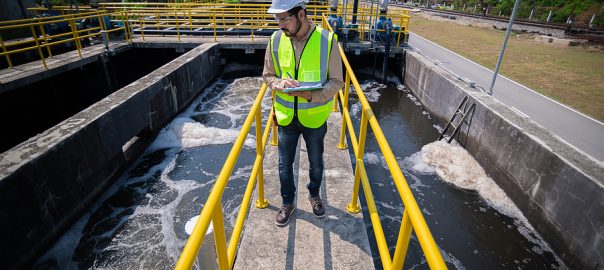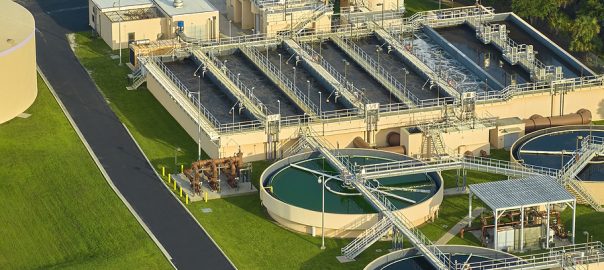
Initial wastewater treatment options in the U.S. involved the use of cesspools or septic tanks with tile drainage, but this was only so helpful as populations increased and cholera epidemics became an issue in cities like Saint Louis, Missouri. By the 1850s, Chicago, Illinois, and Brooklyn, New York, would become the first two cities with official sewer systems.
In those cities, large pipes collected household wastewater, industrial wastewater, and stormwater runoff to plants where waste was filtered through filters (usually sand) before allowing it to proceed to rivers and lakes. Worcester, Massachusetts, was the first city to use chemicals to treat the wastewater, and it took around 40 years to get to that point.
Over 125 years later, municipal wastewater treatment plants are vital to our lives, yet many plants face incredible challenges. On average, a plant’s lifespan is no more than 50 years. What are the top challenges facing today’s wastewater treatment plants?
Climate Change
Climate change may not impact all wastewater treatment plants, but it can impact some. One of the leading issues is in any district that’s still using a Combined Sewer Overflow (CSO). CSOs are starting to decrease in number, but until a city has the finances to enact the change, flooding can create massive issues with excess stormwater flooding a plant and forcing operators to release raw sewage into the area’s lakes, streams, and rivers.
Another problem is heavy rain that causes flooding that gets into your wastewater treatment plant. Most districts build plants on hillsides or away from shores or river banks. They’re in areas where flooding will not impact the plant, but It’s not always possible. If your plant is in floodwaters, it’s going to wreak havoc on the environment by causing untreated wastewater to mix with flood waters and impact rivers, streams, lakes, and the ground surrounding your plant.
Cybersecurity
Like it or not, the risk of hackers getting into your wastewater district’s systems cannot be ignored. You need equipment that is safeguarded by secure protocols and prevents dangerous cyberattacks. In 2021, three water treatment plants in the U.S. faced ransomware attacks, but manual controls prevented any major issues. Make sure your plant is equipped with security and options where you can manually control equipment if necessary.
Finances
Financial constraints are another factor that can impact your district’s wastewater treatment plant. If you’re not getting grants from government agencies and experiencing increased energy bills and maintenance costs from the use of older equipment, your bills increase. Your options are to increase rates, but you’re going to anger the people in your district. Federal rate increases are impacting their lives, too.
Finding ways to save money is important. As you can, upgrade equipment to lower the amount of downtime and maintenance. Upgraded equipment works faster and can be automated to monitor increases as people get home and do the laundry and cook meals or shower and get ready for work or school. It also can shut motors off as needed during slower periods when people sleep.
Increasing Operating Costs
Electricity costs in the U.S. went up from an average of 8.45 cents to 8.6 cents (per kilowatt-hour) for the industrial sector. This may not seem too alarming until you think about how much electricity is used 24/7 at a wastewater treatment plant. It’s estimated that the bubble diffusers that are necessary for aeration can use anywhere from 30,000 kWh to 50,000 kWh per day. The more efficient your wastewater treatment equipment is, the more money you save.
Growing Populations
In the 2021 Report for America’s Infrastructure, it was reported that 15% of the nation’s wastewater treatment plants are over their plant’s maximum capacity. One more home on an already overwhelmed plant can be catastrophic. In addition, 81% of the nation’s plants are at capacity. At that point, it was going to take more than $3 billion to replace the nation’s sewer lines, which was almost $20 per customer.
That’s just necessary pipeline upgrades. There are also issues with outdated equipment and the high cost of maintenance that is eating up district budgets. It’s estimated that there is an $81 million infrastructure gap that’s making it hard for wastewater treatment plants to make necessary upgrades.
Cities and towns in a wastewater district have to carefully weigh how many new homes are built, but it’s hard to control some aspects like how many people are living in a new home without catching people off guard and demanding to do a headcount, which isn’t going to be welcomed.
There are state and local codes that determine how many people can live in a unit. These codes are in place to prevent strain on the infrastructure. A general rule is no more than two people per bedroom. In a three-bedroom home, there shouldn’t be more than six full-time residents. Leaving some room for population growth is important.
Newer Contaminants
Another leading problem wastewater treatment plants experience involves the newer contaminants that need to be removed from wastewater. Pharmaceuticals are one of them.
Studies show that common medications like antidepressants are tough to remove from wastewater, and they do impact fish and other aquatic creatures. If a fish is contaminated with these medications, studies show it impacts their fertility. This could cause shortages of seafood in stores and in our diets.
PFAs are another newer contaminant that wastewater treatment plants need to address. Granulated activated carbon, high-pressure membrane, and ion exchange resin treatment processes can all help remove PFAs, which is something the EPA is starting to crack down on with Effluent Guidelines Program Plan 15.
Outdated Equipment
Many wastewater treatment plants rely on outdated equipment. This equipment is less efficient and drives up energy bills and can decrease how quickly wastewater is cleaned and released.
This can lead to increased energy costs, decreased treatment efficiency, and increased environmental impacts.
In the U.S. the average age of underground wastewater and drinking water pipes is 45 years. Some districts are working with pipes that are at least 100 years old. When districts struggle to replace pipes within their district, it’s not surprising that equipment is often decades old and failing before it’s replaced.
Many of the nation’s wastewater treatment plants were built when the Clean Water Act of 1972 passed. If a plant hasn’t replaced equipment since 1972, the equipment is likely outdated and in need of urgent replacement.
It’s Time to Act
The challenges facing the nation’s wastewater treatment plants are significant, but President Biden’s American Jobs Plan has provided some necessary funding to get to work improving the nation’s infrastructure. Of the $111 billion for water infrastructure improvements, $56 billion in grants and low-interest loads are available for wastewater, stormwater, and drinking water systems.
Look into these grants and low-interest loans to address the biggest issues facing wastewater treatment plants. When you work with experts in water treatment, you’ll get expert guidance into the improvements you should make right now vs. months or years later.
Lakeside Equipment can talk to you about the upgrades you should make and how you should time them to ensure you are not creating a financial strain on your district’s customers. Talk to our wastewater treatment experts to discuss what your goals are and discover the best ways to enact these changes while sticking to your district’s budget.





